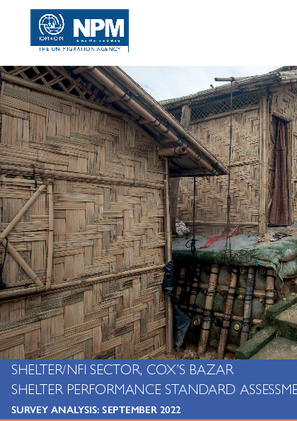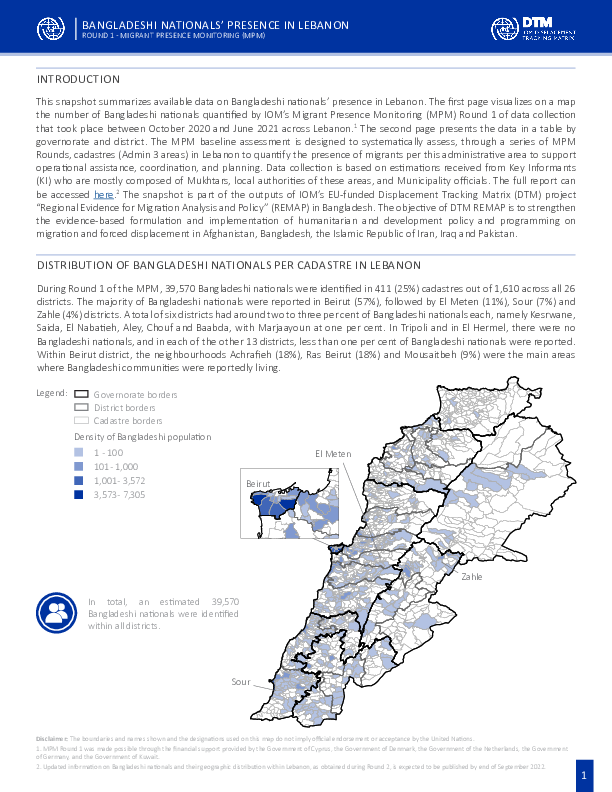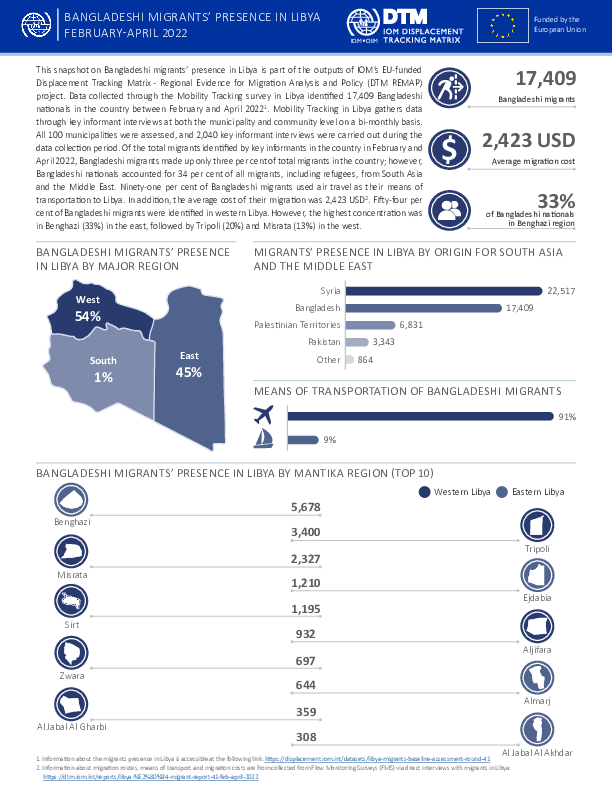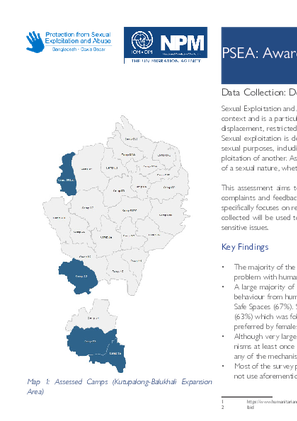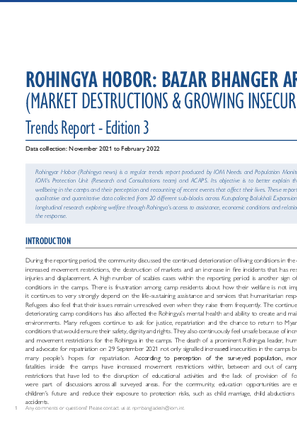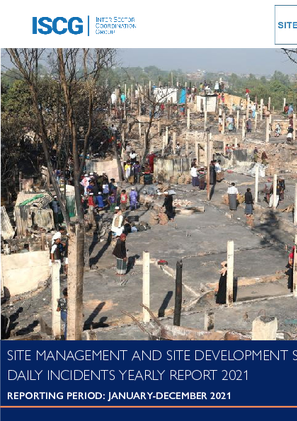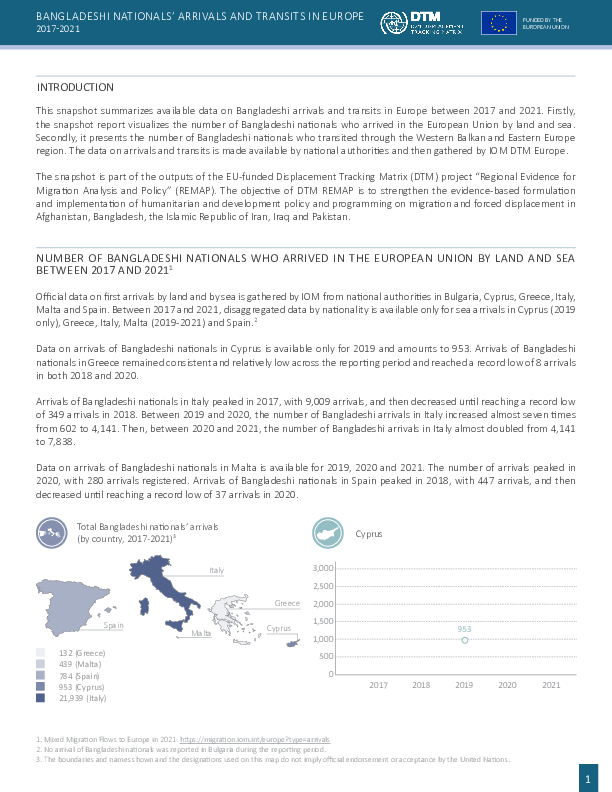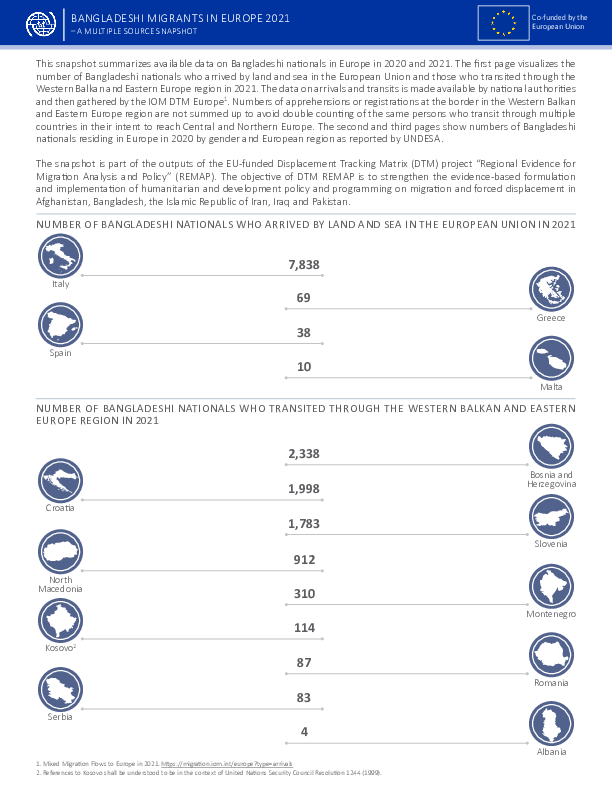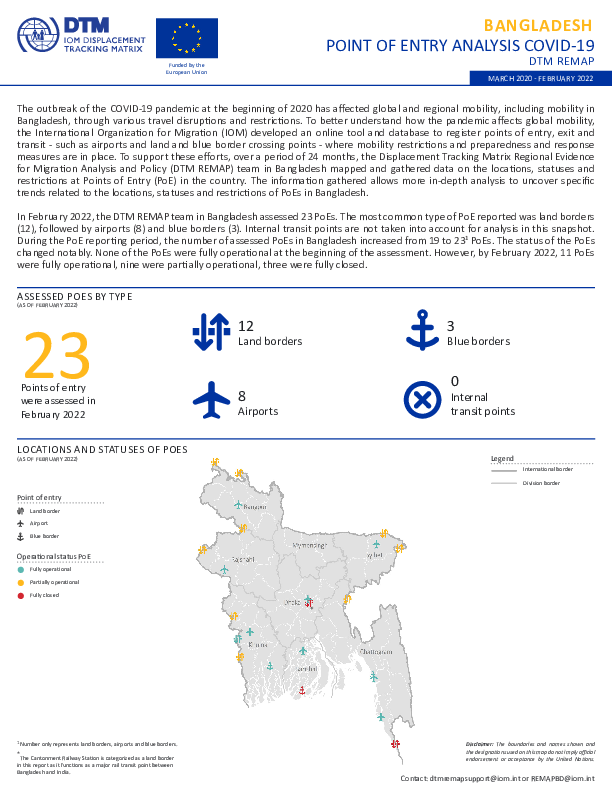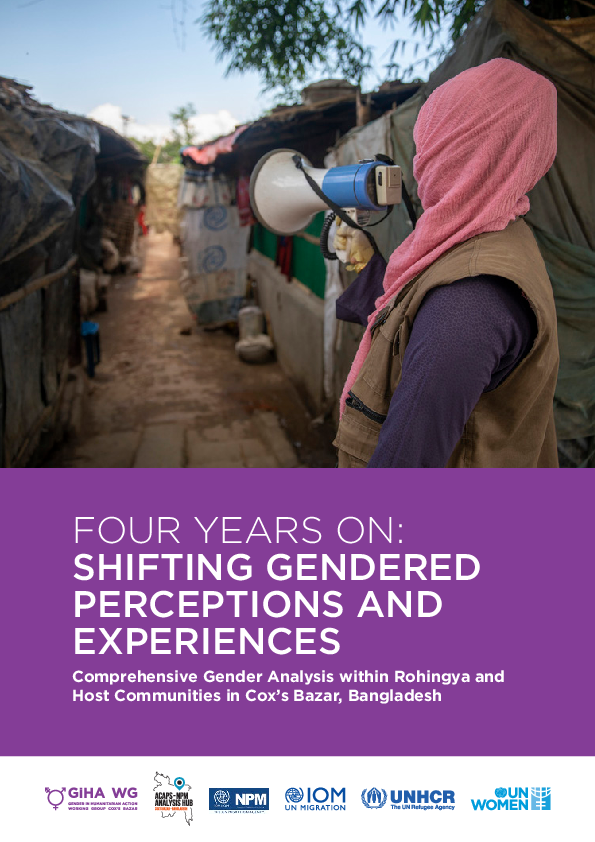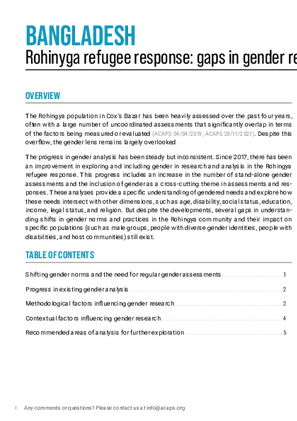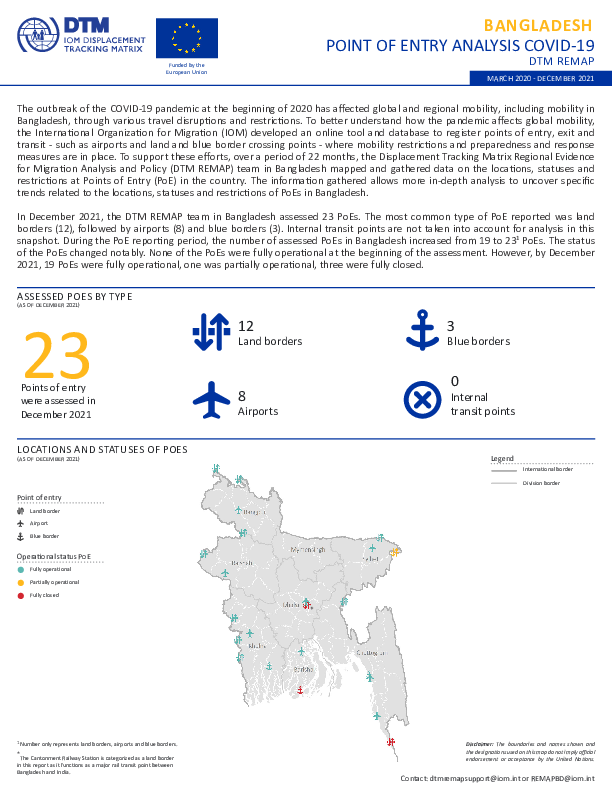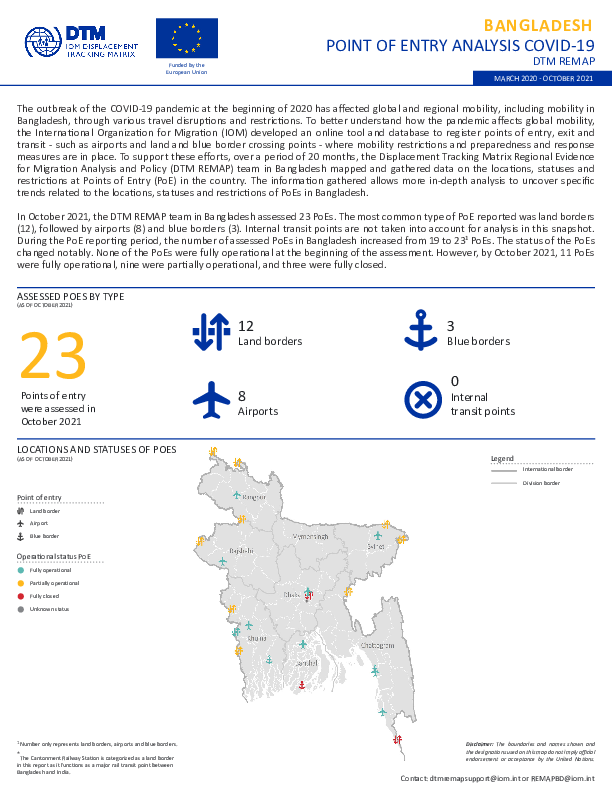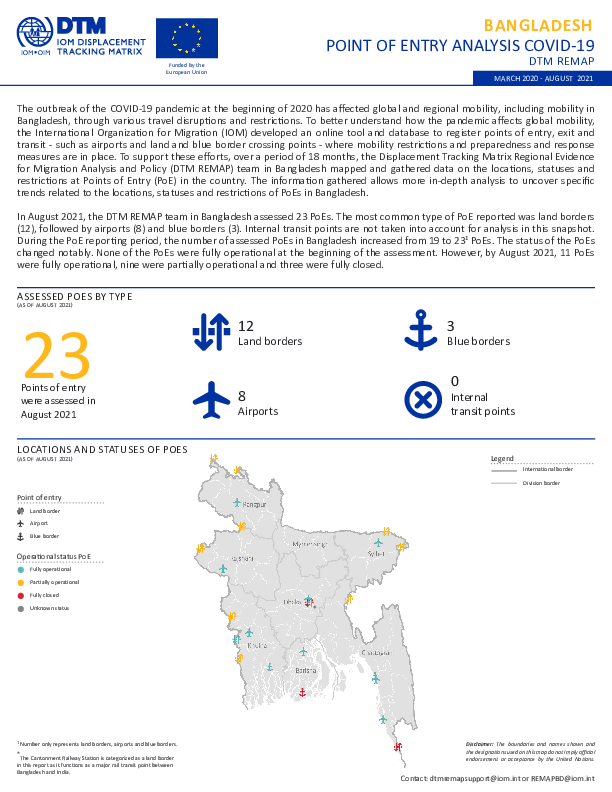-
Countries
-
Data and Analysis
-
Special Focus
-
Crisis Responses
Bangladesh
Bangladesh
Desplazados internos rastreados
Movimientos de desplazamiento
426,000
IDMC 2023
Ronda de recopilación de datos
Sobre Bangladesh
IOM Bangladesh Needs and Population Monitoring (NPM) tracks population numbers, movements and needs to inform the Rohingya humanitarian response in Cox Bazar. IOM Bangladesh Needs and Population Monitoring (NPM) is part of IOM’s global Displacement Tracking Matrix (DTM) programming. DTM is IOM’s information management system to track and monitor displacement and population mobility. It is designed to capture, process, and disseminate information to provide a better understanding of the movements and evolving needs of displaced populations, whether on-site or en route regularly and systematically. IOM Bangladesh NPM was first launched in Cox’s Bazar district in early 2017 and has consistently been a key data provider in the Rohingya humanitarian response. Access the NPM Portal for the most recent products.
IOM’s Needs and Population Monitoring (NPM) unit works to support evidence-based humanitarian decision-making and prioritization by tracking needs and vulnerabilities among both Rohingya and the host communities in Cox’s Bazar. Through NPM’s broad information management framework, service providers can access and make use of comprehensive data and analysis on the needs and vulnerabilities of affected populations, promoting more informed and nuanced humanitarian programming. NPM successfully partners and cooperates with the Inter-Sector Coordination Group (ISCG), various sectors, such as Shelter and Camp Coordination and Camp Management (SCCCM), and humanitarian partners, particularly through designing and conducting a wide range of assessments and providing ad-hoc data collection services, as well as technical information management and GIS with Drone support. In addition. Since 2018, REACH Initiative and NPM closely collaborating in the implementation of the Multi-Sectoral Needs assessments in Rohingya refugee camps and host communities. NPM has also provided field and contextual expertise to Ground Truth Solutions and Translators without Borders. These partnerships serve to strengthen NPM as a key information provider of the response.
Since 2018, IOM, with funding from the European Union, established the Displacement Tracking Matrix Regional Evidence for Migration Analysis and Policy (DTM REMAP) project, to strengthen the evidence-based formulation and implementation of humanitarian and development policy and programming on human mobility, migration, return and displacement in Bangladesh. Under DTM REMAP, IOM Bangladesh conducts various activities in a variety of districts in Bangladesh including: i) Baseline Mobility Assessments (BMA) to inform on numbers and locations of Bangladeshi internal and international migrants; ii) Survey on Drivers of Migration (SDM) to improve the understanding of the drivers of out-migration among Bangladeshi (potential) migrants; iii) Returnee Longitudinal Studies (RLS) to monitor the sustainability of return and needs and vulnerabilities of returnees; iv) Community Based Needs Assessments (CBNA) to inform on characteristics, needs and vulnerabilities of Bangladeshi migrants and their communities.
Current Donors
- European Union
- Australia
- PRM
- DFID
Para obtener resultados de búsqueda más avanzados, vaya a la Página de búsqueda avanzada de informes
Bangladesh – Bangladeshi Nationals' Presence in Lebanon (Round 2, Migrant Presence Monitoring)
This snapshot summarizes available data on Bangladeshi nationals’ in Lebanon from IOM’s Migrant Presence Monitoring (MPM) Round 2. Data collection took place between May and July 2022.
Dec 13 2022
Bangladesh – Bangladeshi Nationals' Presence…
Bangladesh — Flash Flood: Evacuation Centre Assessment, Findings from Sylhet and Sunamganj Districts, Bangladesh (August 2022)
Following the devastating flash floods in May and June 2022 in the districts of Sylhet and Sunamganj, the Displacement Management Cluster, Gender Based Violence (GBV) Cluster, Shelter Cluster and Education Cluster collaborated to assess the flood evacuation centres through partners currently acti
Bangladesh — NPM ACAPS Analysis Hub Report — Challenges in analysing needs over time using MSNA experiences from the Rohingya responses (January 2018 - December 2022)
In late 2021, ACAPS’ Cox’s Bazar Analysis Hub embarked on research to understand the development of humanitarian needs in the Rohingya refugee crisis. The research was mainly based on the comparison of findings from four consecutive years (2018–2021) of Multi Sector Needs Assessments (MSNAs).
Bangladesh — Household’s Perception and Use Of 150 Sq. Feet Shelters (Built for The Fire Response in Camps 9, 8e And 8w) Survey Analysis: October, 2022
In response to shelter reconstruction after the March 22nd fire in 2021, MoDMR shared an “Approval of design for construction of shelters in Rohingya camps” on April 4th (including single storey shelters and specification of the materials to be used) stating that a “single storey shelter of 10 fe
Bangladesh - Remittance Inflows into Bangladesh during COVID-19
This snapshot report on remittance inflows to Bangladesh during COVID-19 is part of IOM's EU-funded project Displacement Tracking Matrix - Regional Evidence for Migration Analysis and Policy (DTM) and the Asia Pacific Regional Data Hub (RDH). The inflow of remittances
Bangladesh — Shelter Performance Standard Assessment (September 2022)
The total number of Rohingya refugees in Cox’s Bazar is around 936,733 individuals1 . The Rohingya refugee population is concentrated in 33 extremely congested camps within Ukhiya and Teknaf Upazilas of Cox’s Bazar district, Bangladesh.
Bangladesh – Bangladeshi Nationals' Presence in Lebanon (Round 1, Migrant Presence Monitoring)
This snapshot summarizes available data on Bangladeshi nationals’ presence in Lebanon.
Sep 19 2022
Bangladesh – Bangladeshi Nationals' Presence…
Bangladesh – Bangladeshi Migrants Presence in Libya – February-April 2022
This snapshot on Bangladeshi migrants’ presence in Libya is part of the outputs of IOM’s EU-funded Displacement Tracking Matrix - Regional Evidence for Migration Analysis and Policy (DTM REMAP) project.
Bangladesh — PSEA: Awareness of Reporting Mechanisms for Sensitive Issues in the Rohingya Camps
Sexual Exploitation and Abuse by humanitarian workers (“SEA”) can occur in any humanitarian or development context and is a particular risk in emergency contexts characterized by violence, gross power imbalance, mass displacement, restricted access, dismantled family and societal structures and g
Bangladesh — “We bear it and accept our fate” Perceptions of healthcare access from people with disabilities in Cox’s Bazar (July 2022)
At any given time, multiple assessments are underway to inform the humanitarian response in Cox’s Bazar, Bangladesh, where more than 929,000 Rohingya have sought refuge since 2017. However, data is lacking on the unique needs, preferences, and perceptions of persons with disabilities.
Bangladesh — Rohingya Hobor: Bazar Bhanger Ar Dhor Barer (Market Destructions & Growing Insecurities) Edition 3 (November 2021 -February 2022)
During the reporting period, the community discussed the continued deterioration of living conditions in the camps, including increased movement restrictions, the destruction of markets and an increase in fire incidents that has resulted in serious injuries and displacement.
Bangladesh — Site Management and Site Development Sector Daily Incidents Yearly Report 2021 (January -December 2021)
Introduction Following the military crackdown in August 2017 in Rakhine State, Myanmar, an estimated 700,000 Rohingya refugees fled to Cox’s Bazar district, Bangladesh.
Bangladesh – Bangladeshi Nationals' Arrivals and Transits in Europe (2017-2021)
This snapshot summarizes available data on Bangladeshi arrivals and transits in Europe between 2017 and 2021. Firstly, the snapshot report visualizes the number of Bangladeshi nationals who arrived in the European Union by land and sea.
May 17 2022
Bangladesh – Bangladeshi Nationals' Arrivals…
Bangladesh — NPM ACAPS Analysis Hub Report — Protection implications of polygamous marriages in the Rohingya camps (January 2018 - December 2022)
In 2017, hundreds of thousands of Rohingya fled Myanmar and settled in the camps in Cox’s Bazar, Bangladesh. The scale of displacement brought obvious changes to their living conditions and changed family dynamics in the camps.
Bangladesh – Bangladeshi Migrants in Europe – A Multiple Source Snapshot (2021)
This snapshot summarizes available data on Bangladeshi nationals in Europe in 2020 and 2021. The first page visualizes the number of Bangladeshi nationals who arrived by land and sea in the European Union and those who transited through the Western Balkan and Eastern Europe region in 2021.
Bangladesh – COVID-19 PoE Analysis Dashboard (March 2020 - February 2022)
The outbreak of the COVID-19 pandemic at the beginning of 2020 has affected global and regional mobility, including mobility in Bangladesh, through various travel disruptions and restrictions.
Bangladesh — Four Years On: Shifting Gendered Perceptions and Experiences - Comprehensive Gender Analysis within Rohingya and Host Communities in Cox’s Bazar
Gender programming as a social intervention, addressing the diverse needs of the affected population and evaluating its impacts, is complex and challenging, particularly in a humanitarian setting where urgent survival needs are prioritised.
Bangladesh — NPM ACAPS Analysis Hub Report — Rohingya Refugee Response: Gaps in Gender Research (January 2018 - December 2022)
The Rohingya population in Cox’s Bazar has been heavily assessed over the past four years, often with a large number of uncoordinated assessments that significantly overlap in terms of the factors being measured or evaluated (ACAPS 04/04/2019; ACAPS 28/11/2021).
Bangladesh — People Living with Disabilities in Cox’s Bazar: Understanding Perceptions on Aid Equity and Access: Preliminary findings (January 2022)
In Cox’s Bazar, identifying and meeting the unique needs of people living with disabilities has been a challenge throughout the humanitarian response, while quantitative assessments and perception tracking have struggled to understand their diverse experiences and perspectives.
Bangladesh – COVID-19 PoE Analysis Dashboard (March 2020 - December 2021)
The outbreak of the COVID-19 pandemic at the beginning of 2020 has affected global and regional mobility, including mobility in Bangladesh, through various travel disruptions and restrictions.
Bangladesh – Bangladeshi Migrants Presence in Libya – March-April 2021
According to available data from the Displacement Tracking Matrix (DTM) in Libya compiled in the following snapshot by the DTM REMAP project, funded by the European Union (EU), 20,123 Bangladeshi nationals were identified through DTM’s baseline Mobility Tracking module in Libya between March and
Bangladesh – Bangladeshi Migrants Presence in Libya – March-April 2020
According to available data from the Displacement Tracking Matrix (DTM) in Libya compiled in the following snapshot by the DTM REMAP project, funded by the European Union (EU), 19,710 Bangladeshi nationals were identified through DTM’s baseline Mobility Tracking module in Libya between March and
Bangladesh – COVID-19 PoE Analysis Dashboard (March 2020 - October 2021)
The outbreak of the COVID-19 pandemic at the beginning of 2020 has affected global and regional mobility, including mobility in Bangladesh, through various travel disruptions and restrictions.
Bangladesh – COVID-19 PoE Analysis Dashboard (March 2020 - August 2021)
The outbreak of the COVID-19 pandemic at the beginning of 2020 has affected global and regional mobility, including mobility in Bangladesh, through various travel disruptions and restrictions.
Pagination
Para obtener resultados de búsqueda más avanzados, vaya a la Página de búsqueda avanzada de conjuntos de datos







